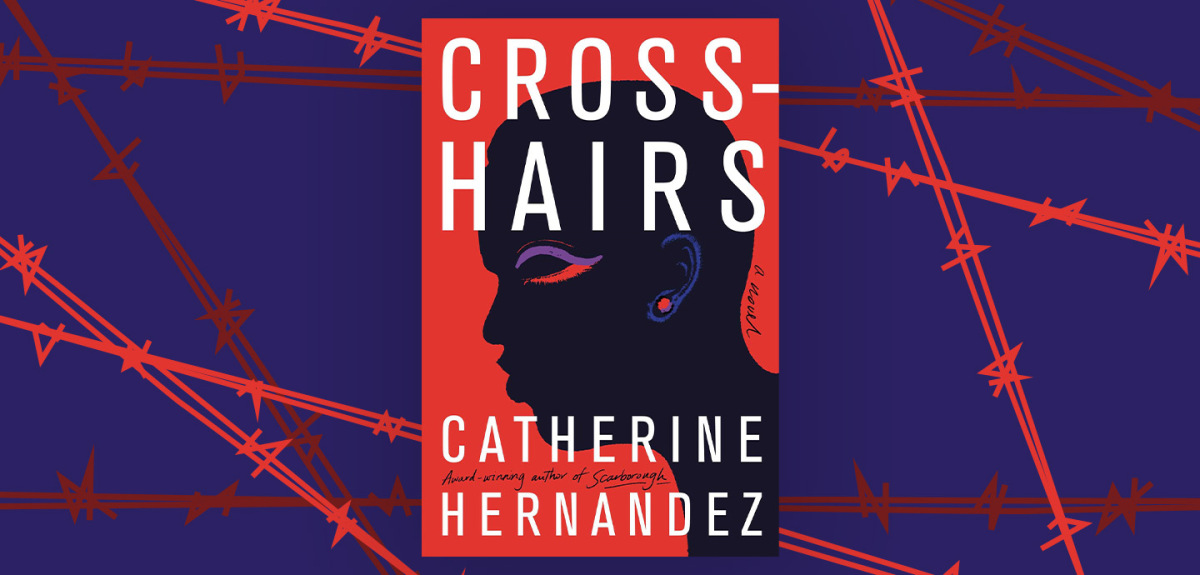[ad_1]
Boldness incarnate. A laugh in the face of subtlety and propriety. These are fragmented phrases to describe Crosshairs by Catherine Hernandez, and they do not go far enough. Hernandez writes for herself, for the communities she represents, and for anyone who has ever felt othered in society. Her feminism is intersectional, her prose electric, and what we’re left with is an astonishing feeling of what do we do now?
The novel follows Kay, a young gay man who is half Filipino and half Jamaican, as he writes an unsent letter to his lover. They’ve been separated by a facist government intent on dividing, discriminating, and eliminating all those from marginalized communities, wreaking havoc on Black and Brown bodies. We weave in and out of the present as we learn about Kay’s traumatic upbringing, his sense of community and identity as he performs in drag shows, and his desperate love for Evan. We’re introduced to allies and enemies and everything in between. In a book as dramatic as this, Hernandez takes a moment to pause and remind those of us who are not Othered of what allyship should be. This is immortalized in a chant:
When I do not act, I am complicit!
When I know wrong is happening, I act!
When the oppressed tell me I am wrong, I open my heart and change!
When change is led by the oppressed, I move aside and uplift!
This chant is spoken multiple times and referenced even more. Hernandez depicts allyship as it should be: a conscious, continuous process. Crosshairs unpacks other terms, such as white saviorism, intersectionality, and resistance. In one such example, Kay describes being renamed ‘Caramel Kay’ rather than the chosen name ‘Queen Kay’. The Black body is at once exoticized, fetishized, and reduced to an item of consumption. Kay is even unable to find a matching foundation in a shade unrelated to food, a plight familiar to many Black and Brown people. In just this subtle way, we are shown that even the freewheeling world of drag must reckon with its limitations, its outright racism, and other flaws.
If one had any doubt as to what these ideas really mean in a fragmented world, doubt no longer. Hernandez has taken the time to educate us all. Ignorance is not an excuse anymore.
However, this book is no educational treatise, and excels as an example of craft and characterization, not just as a political statement. Frequent fluctuations between past and present tense lend an immediacy to the novel’s prose. Bodies are shown in various states of transformation — joyous in Kay’s performance days, horrendous in the concentration camps. We are thrown violently from horror to joy to numbness to hope, and back again. Kay is nearly overshadowed by members of the Resistance, such as the foreboding Liv, the well-meaning Beck, the tragic Firuzeh, and so many others. While the story sometimes takes breaks to make way for education, breaks that can disrupt the narrative rather than add to it, these hardly overshadow the potency of such a story. What Hernandez presents us is a twisted universe that is even more haunting, because it is real.
We are reminded that in Canada and the United States, being Othered in society has dangerous consequences. That democracy and equality are not privileges enjoyed by all. That there are identities that cannot be code-switched, hidden, or made up for. That we all deserve the chance to spread our wings, to find love and comfort and fulfillment, and to live as big as we want to live.

FICTION
Crosshairs
By Catherine Hernandez
Atria Books
Published December 8, 2020
[ad_2]
Source link
